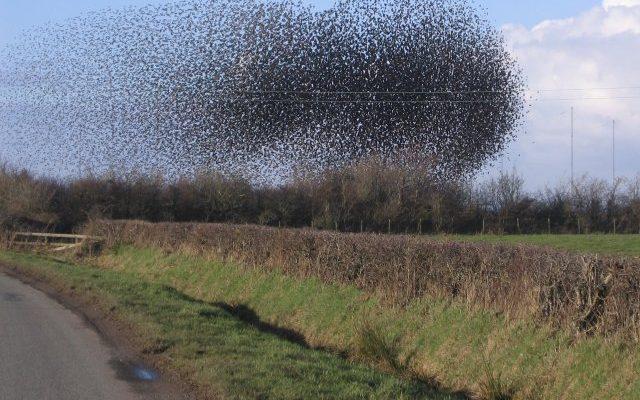Autumn is a special season. It is colorful: bright blue skies; spectacular aqua, orange, yellow, and pink sunsets; leaves that change into warm reds, yellows, and oranges; grandiose orange harvest moons profiled against dark shadowy woodlands. Autumn offers unique tastes and spices. And it creates unique patterns: especially the swarms of starlings (at least I think that they are starlings) that form fascinating, fluid shapes in midair.
These are called murmurations. Hundreds — even thousands — of starlings fly together to create three-dimensional, ever-morphing patterns. And all Eastern Shore residents have to do is to “look up.”
Scientists and birders have been fascinated by them. They study their patterns and have documented murmurations that last as long as 45 minutes.
Starlings and African Queleas are some of the few birds that create murmurations. Other birds, such as crows, fly in flocks and formations, but do not murmurate. Flocks are groups of birds that congregate and fly in patterns, such as the “V” formation of geese, but they do not create the fluid patterns of a murmuration.
Starlings are well equipped for this spectacle because their lateral eyesight enables them to have almost a 360 degree field of vision.
The rules to achieve a murmuration are surprisingly simple. The first is the rule of SEVEN. Starlings follow their seven closest neighbors.
Murmurations appear as if the starlings are drawing together more densely and then scattering. But this is an optical illusion, the 3-D shape being projected onto our 2-D view. Pulsating in waves and swirling into arrays of shapes, it appears as if there are areas where birds slow, and become thickly packed in, or where they speed up and spread wider apart. But this, too is an optical illusion. The birds are, in fact, flying at a steady speed, playing “follow the leader” by copying the behavior of the nearest bird in their group of seven.
Here are the simple rules to create a murmuration.
- Follow the seven nearest neighbors, so if one turns, they “follow the leader.”
- Fly toward their group, without crowding.
Why do starlings murmurate? Scientists don’t know. Some think that they do it to confuse predators, a recently disproven hypothesis was that they did it to generate heat.
Some ornithologists hypothesize that they do it just for the joy of moving together.
Last week, I pulled over just to watch them. Their synchronicity was magnificent, their dotted patterns unpredictable. It looked like fun, like line dancing. So, maybe they are doing it just for the sheer joy of movement and building something together.
Why not?
Angela Rieck, a Caroline County native, received her PhD in Mathematical Psychology from the University of Maryland and worked as a scientist at Bell Labs, and other high-tech companies in New Jersey before retiring as a corporate executive. Angela and her dogs divide their time between St Michaels and Key West Florida. Her daughter lives and works in New York City.



Kathy Kopec says
Thanks for your informative article on one of my favorite things to experience. I also pull off to the side of the road to watch these aerial ballets. Along rt.328 is a great spot to see these. It’s joyful & mesmerizing.Many mornings I can watch them from my bedroom window. Even the word “murmuration” is fun to say.
Dodie Theune says
I learn something every time I read Angela’s articles.